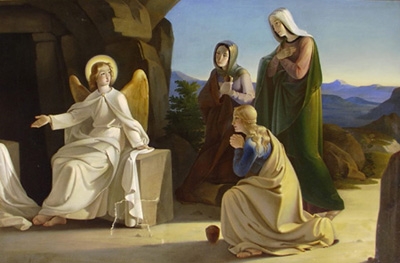Mary Magdalene
Mary Magdalene
A famous college in Oxford, the Cathedral of the Magdalene in Salt Lake City, and countless girls and women have been named after Mary Magdalene The Da Vinci Code made her into a folk hero--once again--of questionable reputation.
And while we still haggle about her true identity, Mary Magdalene has become a serious contender for number one among the women around Jesus. There exists--in certain quarters--a lively competition between Mary of Magdala and Mary of Nazareth. Full-bodied and long-haired--as most painters liked to paint her--and generous in her heart and with her magic jar--as some spiritual romantics care to imagine her--Mary Magdalene attracts and receives the fan votes of all those who find the other Mary, Mary of Nazareth, a bit remote, abstract and too aloof for their taste.

However, there exists an even stronger competition between Mary Magdalene and Mary Magdalene herself. Is she three in one, or three altogether different personages? Whom should we trust? The Magdalene of the Gospels or the Magdalene of the Apocrypha? Is she the sinner of Luke or the sister of Martha? Or is she the Gnostic Mary of the Gospel of Philip, and thus to be reckoned with as a powerful disciple of Christ, the first of the Apostles? In the Apocrypha, Saint Peter himself addresses this request to Mary Magdalene: "Sister, we know that the Savior loved you more than the rest of women. Tell us the words of the Savior which you remember--which you know but we do not, nor have we heard them."
Who is this Mary of Magdala? Apparently she is not the unknown sinner who anointed the feet of Jesus (Luke 7,36), nor the sister of Martha. From the Gospel we do conclude that she was the one from whom Jesus had cast out seven devils (Mk 16,9 and Lk 8,2); that she is one of the women who ministered to the needs of Jesus (Lk 8,2); that she was a witness of the crucifixion (Mt 27-56; Mk 15,40 and John 19,25); that she was present at the burial of Jesus (Mt 27,61; Mk 15,47), and that she was at the empty tomb. (Mt 28,1-10; Mk 16,1-8; Lk 24,1-12) The Gospel of John specifically says that she was the first to whom the risen Lord appeared. (Jn 20,11-18)
In today's Gospel, particularly, Mary Magdalene is described as a faithful disciple in three ways (Jn 20,11-18):
First, she seeks and finds Jesus. Jesus, in verse 15, asks her: "Whom do you seek? (tina zeteis) The verb zetein for the Johannine community meant probably more than to seek. It suggests to study, to act like a disciple. Mary, the disciple, seeks and finds Jesus.
Second, Mary is one of Jesus' own. Jesus calls her by her name, in verse 16, and she knows his voice, the voice of the shepherd, friend and t eacher.
Third, she responds to Jesus as teacher, Rabbouni, like a true and loving disciple. This epiphany of the risen Christ to Mary and her faithful response establish her as a major witness of the Resurrection.
If these three points are taken cumulatively and collectively, then we have a powerful image of the Church: a community of disciples, witnessing the presence of the risen Lord, participating in the divine Revelation, and announcing it to a stunned and critical world.
It is interesting to note that Leo the Great speaks of Mary Magdalene as a figure of the Church.
There we have it: Mary Magdalene in all her complexity symbolizes what we are and what we are called to be, the Church of Christ.
On an even more concrete and ordinary level, Mary Magdalene embodies the ability of the disciple to do what is necessary and to create or make circumstances:
The Roman philosopher, Marcus Aurelius (121-180), had this expression: "The greatest part of what we say and do is really unnecessary. If you take this to heart, you will have more leisure and less uneasiness." Mary of Magdala understood and demonstrated that the one thing necessary is to seek and to find Jesus. Here is my question for each one of us: How about seeking and finding Jesus to have more leisure, meaning peace, joy and holy indifference? How about seeking and finding Jesus to have less uneasiness--meaning less restlessness, frustration, self-laceration or loss of self-confidence?
Mary Magdalene will help us also to make circumstances. George Bernard Shaw once said: "People are always blaming their circumstances for what they are. I don't believe in circumstances. The people who get on in this world are the people who get up and look for circumstances ... and if they can't find them, (they) make them." Mary Magdalene strikes me as a woman who is able to make circumstances. The way to the empty tomb, from there to the encounter with the gardener, and back to bring the good news to the college of apostolic men, was not exactly what we call a lame-duck approach. Mary Magdalene was too much of a loving woman-disciple not to get up and look for circumstances ... even to make them, in order to find her Lord and serve his cause. We are not called to make hot air or big waves, but true discipleship always implies the courage to make circumstances.
And so today we pray that we may proclaim Christ as our living Lord and one day see him in Glory (opening prayer), and that we be filled "with the same faithful love that kept Mary Magdalene close to Christ."
All About Mary includes a variety of content, much of which reflects the expertise, interpretations and opinions of the individual authors and not necessarily of the Marian Library or the University of Dayton. Please share feedback or suggestions with marianlibrary@udayton.edu.
